Star Types
Red Giants




You should know
» Red Giant Star - a luminous giant star of low or intermediate mass (roughly 0.5-10 solar masses) that is in a late phase of stellar evolution. Supergiant stars occupy the top region of the H-R diagram and are usually classed as either "Red" or "Blue" Supergiants. The most luminous within this category are typically referred to as hypergiants. A more detailed study into the Supergiant class appears in the chapter on "Supergiants".
» Triple-alpha Process - nuclear fusion reactions by which three helium nuclei (alpha particles) are transformed into carbon
» Electron Degeneracy Pressure - states that two fermions cannot occupy the same quantum state at the same time. The force provided by this pressure sets a limit on how much matter can be squeezed together without it collapsing into a black hole. It is an important factor in stellar physics because it is responsible for the existence of white dwarfs. Referencec Credit: Wikipedia
» Solar Mass - in astronomy it is used to describe the masses of other stars and galaxies. It is equal to the mass of the Sun, 332,950 times the mass of the Earth, or 1048 times the mass of Jupiter. The solar mass can be determined from the length of the year, the distance of the Earth to the Sun (the astronomical unit) (AU), and the gravitational constant G.
» Red Supergiant - are enormous, cool stars with high luminosity that forms after a star has used up the fuel at its core, Thus, the red giant may have a diameter 10 to 100 times that of our sun, but will consequently have a lower temperature of 2000-3000°C.
consuming the last resources
This star is old, it's age measured in billions of years. The fuel that was once so abundant, hydrogen, is running out. During it's life time the star's own thermonuclear engine has been producing the heavier element helium which is now moving inwards, until only a shell of hydrogen remains around the exterior of the core. As this happens, the star's own gravity begins to shrink this core, causing an increase in tempeture and beginning a period of hydrogen to helium burning with the results that it's outer layers begin to expand greatly, increasing the area that the core must heat. It is at this point that the star becomes a red giant, it's own increase in size causing the light energy from the core to move towards the red end of the spectrum and giving this star both it's name and color.
In this section we'll quickly look at 5 prominent and bright Red Giants in the night sky: Aldebaran (Alpha Tauri), Arcturus (Alpha Bootis), Gamma Crucis (Gacrux) and the larger red supergiants Antares (Alpha Scorpii) and Betelgeuse (Alpha Orionis).
red eye of the bull
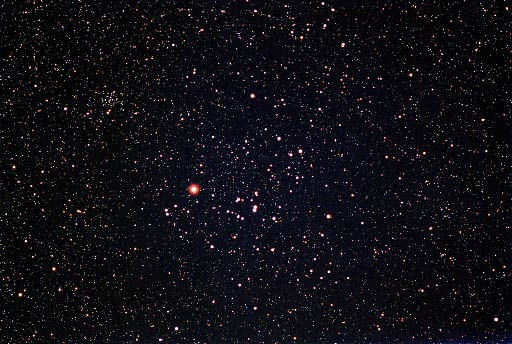
The Red Giant star Alpha Tauric seen above, is positioned in the open star cluster of the Hyades in the constellation of Taurus and referred to in myth as the red eye of the bull. Image Credit: © T. Credner & S. Kohle All the Sky website
| STAR NAME | S-TYPE | LOCATION Ra & Dec ICRS |
AKA |
| Alpha Tauric | K5III | 04 35 55.2387 +16 30 33.485 |
Aldebaran, HD 29139, SAO 94027 |
Reference Source: C.D.S. - SIMBAD4 rel 1.101 - 2008.11.15CET17:01:49

Image Credit: Aladin Sky Atlas
Red Eye of the Bull & the Sow
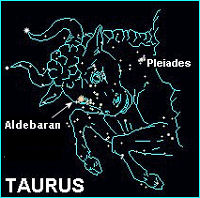
"Hyades: The other cluster of stars in Taurus form the face or forehead of the bull, are called the Hyades, and were put there to commemorate the sister's mourning of their brother Hyas who was the first-born of the Hyades. The Hyades lived on Mount Nysa and nurtured the infant Bacchus/Dionysus (God of wine; wine is from grapes. Bacchus might be the constellation Crater). The word comes from Greek Huades, probably from Hys meaning 'pig'. In Ancient Greek the Hyades cluster of stars were 'the rain-bringers' from hyein, 'to rain'; so called because the wet weather begins when they set. Aldebaran, the alpha star marking the left eye of the bull was sometimes included with the Hyades, and was called a 'Sow'; the colloquial title among the Roman country-people for the Hyades was Suculae, 'the Little Pigs', from Sus, 'Sow'. It was said that the title might come from the resemblance of this group of stars to a pig's jaws; or because Aldebaran and its companion stars were like a sow with her litter. Pliny accounting for it by the fact that the continual rains of the season of their setting made the roads so miry that these stars seemed to delight in dirt, like swine. "
Reference Source -
Constellations of Words Explore the etymology and symbolism of the constellations. The above comes from the page "Taurus the Bull". This is an extremely well presented and intelligent web site with solid reference sources.
215,000,000,000,000 miles away
and brightest in the northern sky
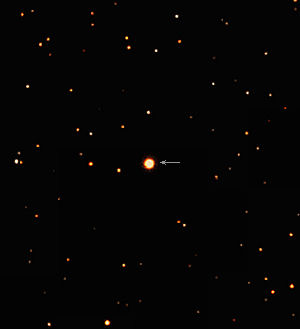
Image Credit: ESO
| STAR NAME | S-TYPE | LOCATION Ra & Dec ICRS |
AKA |
| Alpha Bootis | K1.5III | 14 15 39.6720 +19 10 56.677 |
Arcturus, HD 124897, SAO 100944 |
Reference Source: C.D.S. - SIMBAD4 rel 1.101 - 2008.11.15CET18:40:41
One of the nearest giants to the Earth, at a distance of 11.3 parsecs, it is also the brightest star in the northern sky with an apparent magnitude of -0.10, a spectral type of K1.5III and an effective temperature estimated to be around 4300°K. However, unlike our Sun, Arcturus has already exhausted its central hydrogen and has evolved away from the main sequence group of stars.
The Boatman, Boötes & Arcturus
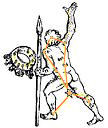
"Bootes, the Boatman is visible in the Northern Hemisphere in spring through the summer. In ancient times Bootes was the driver of oxen or the ploughman of the Triones. In more recent times he is thought to be the Driver of Asterion and Chara in their pursuit of the Bear (Ursa Major) around the pole." [ The Stellar Guide ]

Arcturus appears almost directly overhead before midnite in the early part of the summer, eventually sliding off to the west. It can be found by following the curve outward on the handle of the Big Dipper.

The name of the star derives from ancient Greek Arktouros and means "Bear Guard". This is a reference to it being the brightest star in the constellation Boötes. In Greek mythology, Arcturus is a star created by Zeus to protect the nearby constellations, Arcas and Callisto (Ursa major and Ursa minor).
Reference: Etymology and cultural significance at answers.com
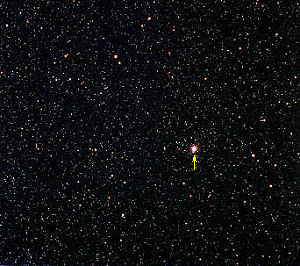
Here is another image from All the Sky website showing the brightest star in the Constellation of Bootes, Arcturus. Image Credit: © T. Credner & S. Kohle
For further reading or study:
» Internet Encyclopedia of Science
» High resolution spectrum of Arcturus
Topping the Southern Cross
The mechanism that ends the collapse of the core and the ascent up the red giant branch depends on the mass of the star. For the Sun and red giants less than 2.57 solar masses, the core will become dense enough that electron degeneracy pressure will prevent it from collapsing further. Once the core is degenerate, it will continue to heat until it reaches a temperature of roughly 108 K, hot enough to begin fusing helium to carbon via the triple-alpha process. Once the degenerate core reaches this temperature, the entire core will begin helium fusion nearly simultaneously in a so-called helium flash. In more massive stars, the collapsing core will reach 108 K before it is dense enough to be degenerate, so helium fusion will begin much more smoothly, with no helium flash. Once the star is fusing helium in its core, it contracts and is no longer considered a red giant. The core helium fusing phase of a star's life is called the horizontal branch in metal-poor stars, so named because these stars lie on a nearly horizontal line in the H-R diagram of many star clusters. Metal-rich helium-fusing stars instead lie on the so-called red clump in the H-R diagram. Reference Source: Wikipedia
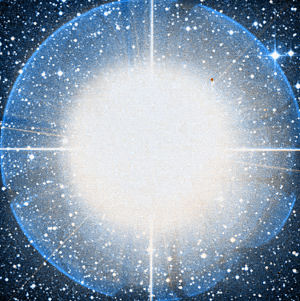
Image Credit: Aladin Sky Atlas
| STAR NAME | S-TYPE | LOCATION Ra & Dec ICRS |
AKA |
| SV* ZI 944 | M3.5III | 12 31 09.9593 -57 06 47.562 |
Gamma Crucis, HD 108903, SAO 240019 |
Reference Source: C.D.S. - SIMBAD4 rel 1.101 - 2008.11.16CET05:41:19
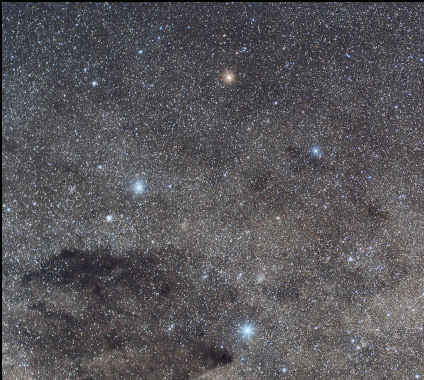
Gamma Crucis, often named Gacrux, is a red giant star approximately 88 light-years away in the constellation of Crux. The star is the third-brightest star in Crux (the Southern Cross) and the 23rd brightest star in the nighttime sky. Seen in the above widefield image Gacrux is the topmost star in the Southern Cross. Reference Source: Sol Station Website
Crux of the Matter
n. pl. crux^es or cru^ces (krsz)
1. The basic, central, or critical point or feature: the crux of the matter; the crux of an argument.
2. A puzzling or apparently insoluble problem.
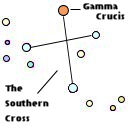
Crux was used by explorers of the southern hemisphere to point south since, unlike the north celestial pole, the south celestial pole is not marked by any bright star.
Both the smallest constellation in the night sky and a modern one, is not visible from latitudes north of 25 degrees. During ancient times the stars that made up this constellation were part of Centaurus. The first mention of the constellation was in 1592 by Emerie Mollineux but it was the French astronomer Augustin Royer who, in 1679, defined this group as a separate constellation. It appears on the flags of Australia, New Zealand, and Western Samoa.
Grown to Big and Getting Smaller
Similar to a Red Giant, a Supergiant occurs once a massive star has used up its hydrogen in the core. It proceeds much like a red giant does, with hydrogen and then helium fusing shells, and also a helium core fusing into carbon, but it doesn't stop there. Because of the higher mass, there is now enough gravitational pressure to cause the carbon core to fuse. If the mass of the star is about 3 to 9 solar masses, the core becomes degenerate before the carbon is ignited. This causes a carbon detonation (a detonation is an explosion) which may blow the star apart, or may cause the star to go Supernova. Stars more massive than 9 solar masses will not undergo carbon detonation, and the carbon core will begin to fuse. In very massive stars, this cycle continues even further. As temperatures increase, successive layers of different fusion shells develop. The star will fuse material until it converts the core into iron. Fusing iron into another element requires more energy than it releases. Stars weren't born yesterday; they won't fuse anything that isn't to their advantage energy-wise, so fusion in the core halts once iron is produced. At this point, the star consists of an iron core (where no fusion is taking place), and shells of silicon fusion, oxygen fusion, neon fusion, carbon fusion, helium fusion, and hydrogen fusion. Because the core can no longer undergo fusion reactions, it will collapse due to gravity, and the star goes supernova. Reference Credit: University of Maryland, Department of Astronomy
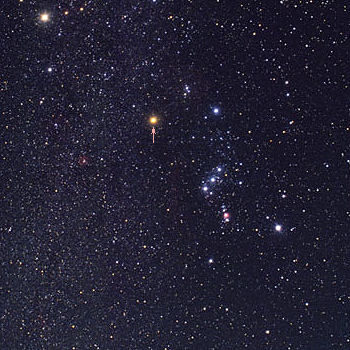
Betelgeuse Image Credit: © T. Credner & S. Kohle All the Sky website
| STAR NAME | S-TYPE | LOCATION Ra & Dec ICRS |
AKA |
| V* alf Ori | M2Iab | 05 55 10.3053 +07 24 25.426 |
Betelgeuse, HD39801, SAO 113271 |
Reference Source: C.D.S. - SIMBAD4 rel 1.101 - 2008.11.16CET04:56:26
How big is this Red Supergiant? Betelgeuse is huge - it has a diameter 662 times bigger than our own sun or 572,588,956 miles in diameter, roughly equivelent to Jupiter's orbit and even though it has a luminosity 135,000 times greater than the sun it's mass is only 20x larger. In other words, it is a huge ball of burning ash/dust, for Betelgeuse is a dying star and it's outer layers of gas and matter are now being blown into space by its stellar winds. One note of interest is that this star is considered as a prime candidate to end as a supernova and should it do so it would become bright enough to be seen easily in full daylight; at night it would light the sky with about as much luminosity as a quarter moon.
To read more about what the future may hold for Betelgeuse see Shedding Light on Betelgeuse and VY Canis Majoris as Future Supernovae. This was a survey conducted with the near infrared spectrograph PHOENIX on Gemini South in order to study the geometry and kinematics of the active circumstellar envelopes in the supergiant stars Betelgeuse and VY Canis Majoris.
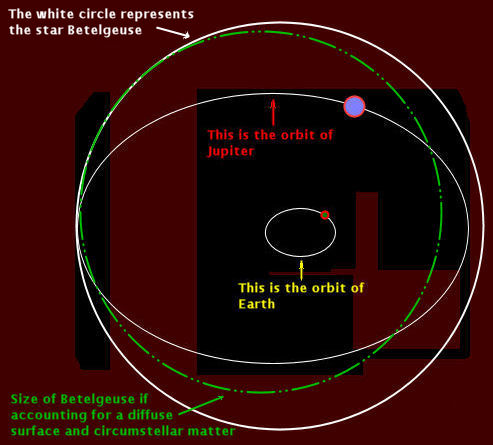
What's in a Name?
Well, for this star it's quite a bit, historically speaking. Writes one source: "the name Betelgeuse is a corruption of the Arabic "yad al jauza," which means the "hand of al-jauza," al-jauza the ancient Arabs' "Central One," a mysterious woman." Source: Stars/Star Of The Week website. Created by Jim Kaler, Prof. Emeritus of Astronomy, University of Illinois. Another sources give the etymological origins of this name similarly: "from the Arabic phrase "Ibt al Jauzah" meaning "The Armpit of the Central One"." Source: Douglas Harper's Online Etymology Dictionary, who gives a date of 1515 for the first time the name appears in written record.
A little investigation however, sheds light on the name discrepancies:
"The history of the curious star name Betelgeuse is a good example of how scholarly errors can creep into language. The story starts with the pre-Islamic Arabic astronomers, who called the star yad al-jawzā', "hand of the jawzā'." The jawzā' was their name for the constellation Gemini. After Greek astronomy became known to the Arabs, the word came to be applied to the constellation Orion as well. Some centuries later, when scribes writing in Medieval Latin tried to render the word, they misread the y as a b (the two corresponding Arabic letters are very similar when used as the first letter in a word), leading to the Medieval Latin form Bedalgeuze. In the Renaissance, another set of scholars trying to figure out the name interpreted the first syllable bed- as being derived from a putative Arabic word *bāţ meaning "armpit." This word did not exist; it would correctly have been ibţ. Nonetheless, the error stuck, and the resultant etymologically "improved" spelling Betelgeuse was borrowed into French as Bėtelgeuse, whence English Betelgeuse."
Source: "Betelgeuse." Dictionary.com Unabridged (v 1.1). Random House, Inc. 29 Dec. 2008

Fast Facts
Located: 640 Light Years ( 3,762,239,879,999,360 miles ) away.
Where: Betelgeuse is found on the shoulder of Orion's belt.
Firsts: Betelgeuse was the first star to have its surface directly imaged, a feat accomplished in 1996 with the Hubble Space Telescope.
Other Facts
» Not everything is fully understood about the dynamics of Betelgeuse. This is due, in large part, to the fact that this star is surrounded by an increasing gaseous shell or circumstellar envelope around it's outer atmosphere, created by the lost of it's own surface as the core shrinks inward. This has cause a few errors and many modifications within the astronomical data that has been written on it.
» A variable star, Betelgeuse is 12th brightest in the sky. It is called Alpha Orionis even though it is fainter than Beta Orionis (Rigel). This is because Betelgeuse was originally misclassified.
» Other names for this star are Betelguex, Betelgeuze, Beteiguex, or Al Mankib.
Akari sees a Bow shock around Betelgeuse
- 19 November 2008 -
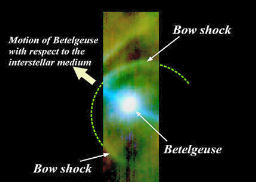
Akari observations of Betelgeuse, a bright red supergiant star located in the constellation Orion about 640 light-years from Earth, show the star making a big splash by creating a bow shock as it crosses the interstellar medium. Researchers have found a strong flow of the interstellar medium around the star which originates from star-forming regions in Orion's Belt.
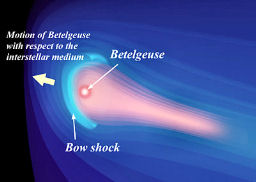
Credit: European Space Agency News
For further reading or study:
» MASS MOTIONS IN THE PHOTOSPHERE OF BETELGEUSE David F. Gray 2008 The Astronomical Journal 135 1450-1458
» Mixing Lasers and Starlight Shows Stars are Larger Than Thought
A Giant amongst Giants
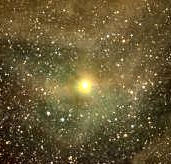
Our last star, Antares, is listed as the 15th brightest star in the sky but don't let that number fool you, this red supergiant is GIANT! Antares is a class M supergiant star, with a diameter of approximately 700 times that of the sun; if it were placed in the center of our solar system, its outer surface would lie between the orbits of Mars and Jupiter. In a digital image, the Sun would be just one pixel in size while Antares would be 10 centimetres (3.9 in) in diameter. Antares is approximately 600 light-years (180 parsecs or 3,527,099,887,499,400 miles) from our solar system. Reference Credit: Wikipedia
Antares is shown below in it's full glory
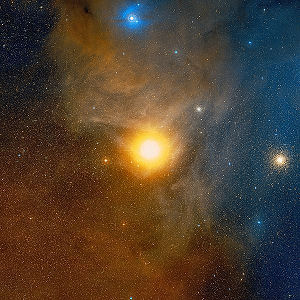
Image Credit: Antares 3° region on DSS2 all sky survey
| STAR NAME | SPECTRAL TYPE | LOCATION Ra & Dec ICRS |
AKA |
| V* alf Sco | M1.5Iab-b | 16 29 24.4609 -26 25 55.209 |
Antares, HD 148478, SAO 184415 |
Antares - Heart of the Scorpion

Credit: Duane Hilton
"ANTARES (Alpha Scorpii). A brilliant jewel set within the Milky Way, Antares guides us to one of the great constellations of the sky, the Zodiac's Scorpius (or Scorpio), the celestial scorpion, one of the few constellations that actually looks like what it represents. Antares, a class M (M1.5) red supergiant gleaming redly at the scorpion's heart, has a color similar to Mars. Since it is found within the Zodiac, which contains the apparent path of the Sun and planets, it is commonly mistaken for the red planet, a fact shown by its name, Antares, or "Ant-Ares," which means "like Mars," "Ares" being the Greek name for the god of war."
Written by Jim Kaler Professor Emeritus of Astronomy, University of Illinois.

"As is common with other red supergiants, Antares lies in a reddish cloud, this one some five light years in diameter. Colored and energized by the radiation from Antares, this cloud is composed of metallic dust, not gas. One of the four Royal Stars of ancient Persia and one of the Guardians of the Heavens, Antares is the splendid red star most probably named for the pre-Muhammad warrior Antarah, hero of one of the seven sacred poems of Arabia, the Golden Mu'allakat. Also called Kalb Aakrab, the Scorpion's Heart, it was one of the fortunate stations always associated with eminence and activity in humanity."
Antares in Scorpio B.Wise Productions

Wide field Imaging in Scorpio
As seen from the above image, the stellar field around Antares lends itself to a variety of colorful imaging across the bands (Halpha, RGB). Most of the stellar gas and dust within this area is energized by the other stars and stellar objects around Antares.
For Further Study and Reading:
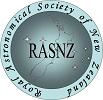
Royal Astronomical Society of New Zealand and the
Southland Astronomical Society Page Scorpius a Constellation for July and August
for further study
The Center for Science Education, UC Berkeley The Stellar Life Cycle
The University of Calgary Centre for Radio Astronomy Imaging the Surfaces of Stars
Red Giants
Variable Stars
Star Page
Main Page
This Page
The Red Giants
Next Page
Variable Stars
Back to Star Page
Back to Main Page
Hubble Space Telescope image of the first direct picture of the surface of a star other than the Sun

APOD-Betelgeuse
Binary Stars
Protostars
Brown Dwarf
White Dwarf
Red giant
Variable Star
Neutron/Pulsar Star
Sections Below are under Construction
Supergiants
Quasars